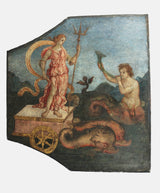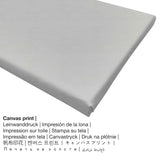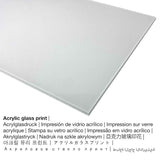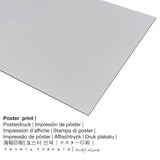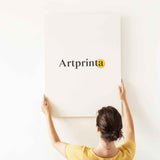Pinturicchio, 1509 - Triomphe d'Amphitrite - tirage d'art
TTC Expédition calculée à la caisse.
Spécifications du produit
Triomphe d'Amphitrite a été créé par Pinturicchio en 1509. L'œuvre mesure la taille de Hors tout: 30 1/2 × 28 po (77,5 × 71,1 cm) et a été conçu sur le support fresque, transférée sur toile et attachée à des panneaux de bois. Aujourd'hui, cette œuvre peut être vue dans le Le Metropolitan Museum of Art's collection numérique. Avec l'aimable autorisation de: Le Metropolitan Museum of Art, New York, Rogers Fund, 1914 (domaine public). La limite de crédit de l'œuvre d'art est: Fonds Rogers, 1914. De plus, l'alignement est en portrait le format and has a side ratio of 1 : 1.2, which means that the length is 20% shorter than the width. The painter Pinturicchio was an artist, whose art style can primarily be attributed to Early Renaissance. The artist was born in 1454 et est décédé à l'âge de 59 ans en 1513.
Vos choix de matériaux de produit
Nous proposons une gamme de matériaux et de tailles variés pour chaque produit. Choisissez parmi les options de produits suivantes maintenant en fonction de vos préférences en matière de taille et de matériau:
- L'impression d'affiche (matériau en toile): A poster print is a UV printed flat cotton canvas with a fine surface finish. Please keep in mind, that depending on the size of the canvas poster print we add a white margin 2-6cm round about the print, which facilitates the framing.
- Impression sur verre acrylique brillant (avec revêtement en verre véritable): An acrylic glass print, which is often named as a an art print on plexiglass, changes your original work of art into brilliant décor. Your favorite work of art will be printed thanks to the help of modern UV direct print machines. The major advantage of an acrylic glass art print is that contrasts as well as granular details become recognizeable because of the granular tonal gradation.
- Impression sur toile: The printed canvas material stretched on a wooden stretcher frame. Further, a canvas generates a cosy and enjoyable appearance. A printed canvas of your favorite artwork will let you turn your art print into a large artwork. How do I hang a canvas print on the wall? The advantage of canvas prints is that they are relatively low in weight, which means that it is quite simple to hang your Canvas print without any wall-mounts. A canvas print is suitable for any type of wall.
- Aluminium dibond (impression métallique): Aluminium Dibond prints are metal prints with a true depth - for a modern look and a non-reflective surface structure. The white & bright sections of the original work of art shine with a silky gloss, however without the glare. The colors are bright and luminous in the highest definition, details of the print appear clear and crisp, and you can literally perceive a matte appearance of the product.
Informations importantes: We try what we can to describe the art products as accurately as possible and to illustrate them visually on the respective product detail pages. Nevertheless, the tone of the print products, as well as the imprint may diverge somehwat from the representation on your monitor. Depending on your screen settings and the nature of the surface, color pigments might not be printed 100% realistically. In view of the fact that the fine art prints are printed and processed manually, there might also be slight differences in the motif's exact position and the size.
A propos de cet article
| Type de produit: | Reproduction d'art |
| Méthode de reproduction: | reproduction numérique |
| Méthode de production: | impression numérique (impression directe UV) |
| Provenance: | produit en Allemagne |
| Type de stock: | production à la demande |
| Utilisation proposée du produit: | mur de la galerie, décoration |
| Orientation de l'oeuvre: | format portrait |
| Rapport d'aspect de l'image: | 1: 1.2 |
| Signification du rapport hauteur / largeur: | la longueur est 20% plus courte que la largeur |
| Matériel de reproduction disponible: | impression en métal (aluminium dibond), impression sur verre acrylique (avec revêtement en verre véritable), impression d'affiche (papier de toile), impression sur toile |
| Tailles de toile sur châssis de civière (impression sur toile): | 50x60cm - 20x24 ", 100x120cm - 39x47", 150x180cm - 59x71 " |
| Impression sur verre acrylique (avec revêtement en verre véritable): | 50x60cm - 20x24 ", 100x120cm - 39x47", 150x180cm - 59x71 " |
| Tailles d'impression d'affiche (papier de toile): | 50 x 60 cm - 20 x 24 ", 100 x 120 cm - 39 x 47" |
| Tailles d'impression Dibond (matériau ancien): | 50 x 60 cm - 20 x 24 ", 100 x 120 cm - 39 x 47" |
| Encadrement impression d'art: | pas disponible |
Détails de l'œuvre d'art
| Nom de l'oeuvre d'art: | "Triumph of Amphitrite" |
| Classification de l'œuvre d'art: | peinture |
| Terme général: | art classique |
| Temps: | 16th siècle |
| Créé en: | 1509 |
| Âge de l'oeuvre: | âgé de plus de 510 ans |
| Support d'illustration originale: | fresque, transférée sur toile et attachée à des panneaux de bois |
| Taille originale (illustration): | Hors tout: 30 1/2 × 28 po (77,5 × 71,1 cm) |
| Exposé dans: | Le Metropolitan Museum of Art |
| Emplacement du musée: | New York City, New York, États-Unis d'Amérique |
| Site Internet du musée: | Le Metropolitan Museum of Art |
| Type de licence d'illustration: | domaine public |
| Avec l'aimable autorisation de: | Le Metropolitan Museum of Art, New York, Rogers Fund, 1914 |
| Ligne de crédit: | Fonds Rogers, 1914 |
Tableau des détails de l'artiste
| Artistes: | pinturicchio |
| Travaux de l'artiste: | peintre |
| Classement de l'artiste: | vieux maitre |
| Styles d'art: | Début de la Renaissance |
| Décédé âgé: | 59 ans |
| Année de naissance: | 1454 |
| Décédé dans l'année: | 1513 |
© Droits d'auteur, www.artprinta.com (Artprinta)
Informations complémentaires sur l'œuvre originale sur le site Internet du musée (© Copyright - The Metropolitan Museum of Art - Le Metropolitan Museum of Art)
L'un des vingt-deux panneaux (14.114.1 – .22) formant le plafond du palais de Pandolfo Petrucci, appelé Il Magnifico, Sienne. La distribution générale et la partition du plafond semblent dériver de celles d'un plafond voûté et peint de la Maison dorée de Néron à Rome. Beaucoup de personnages individuels semblent également provenir d'œuvres d'art antiques - en particulier des sarcophages.

